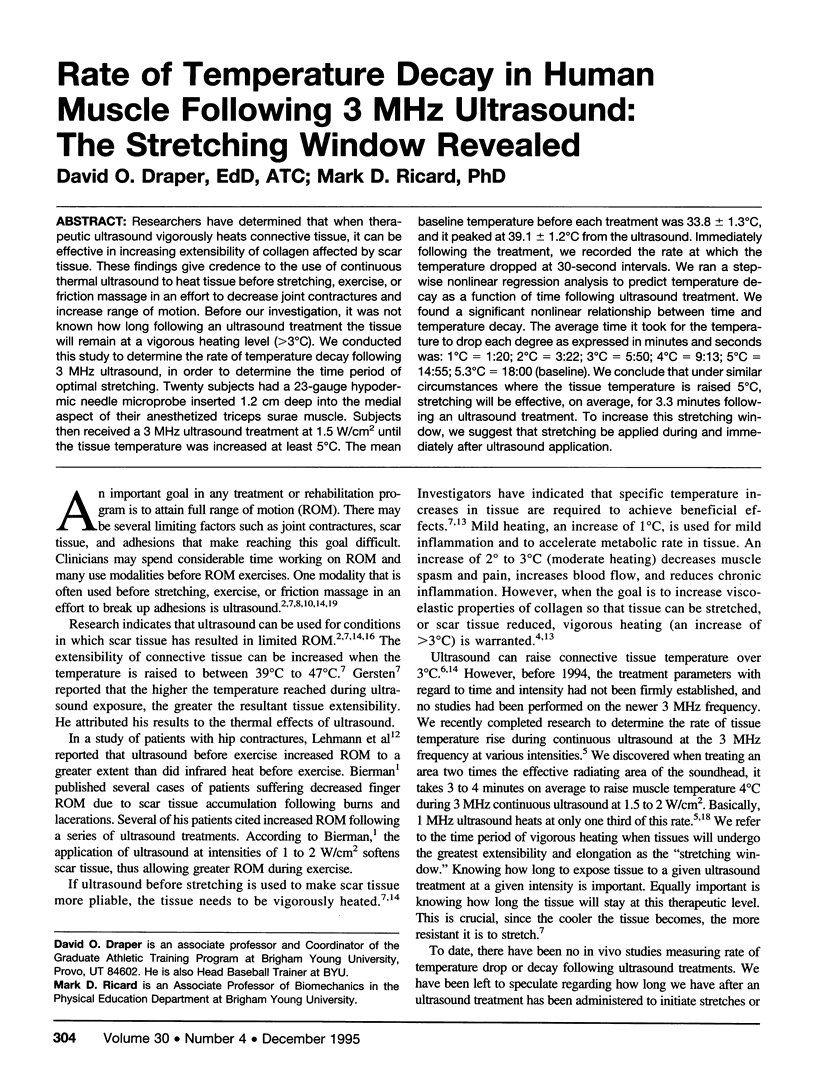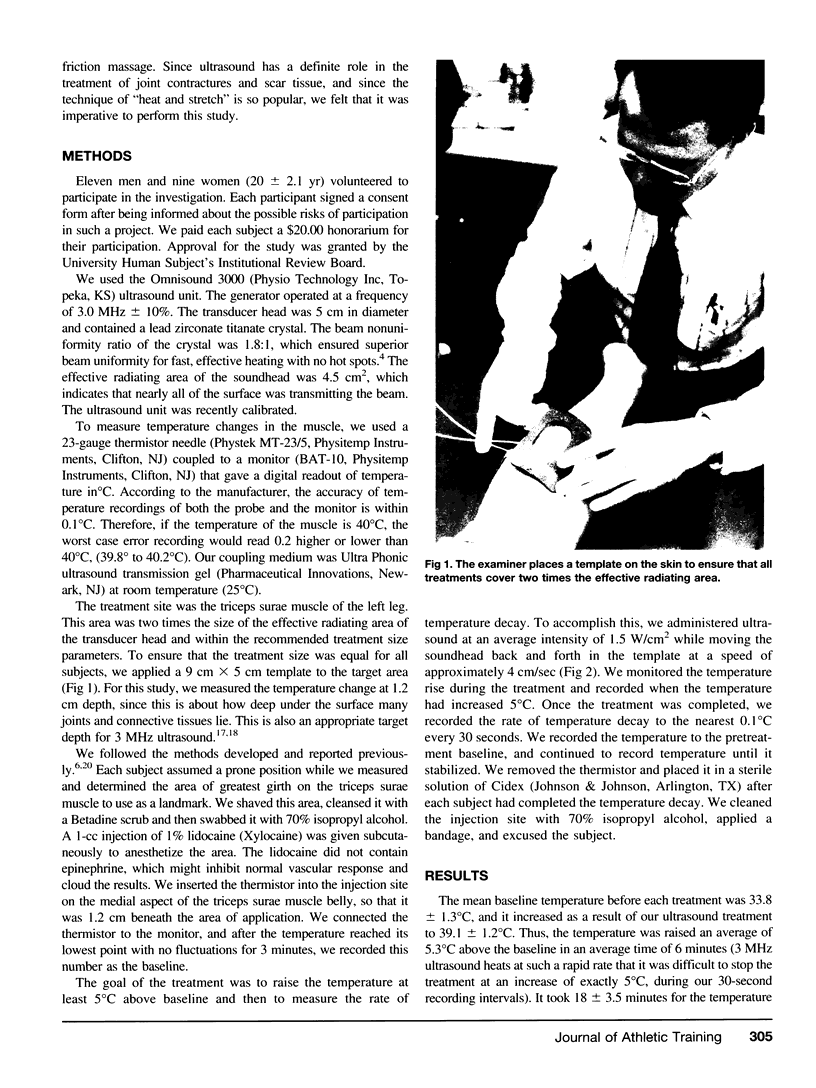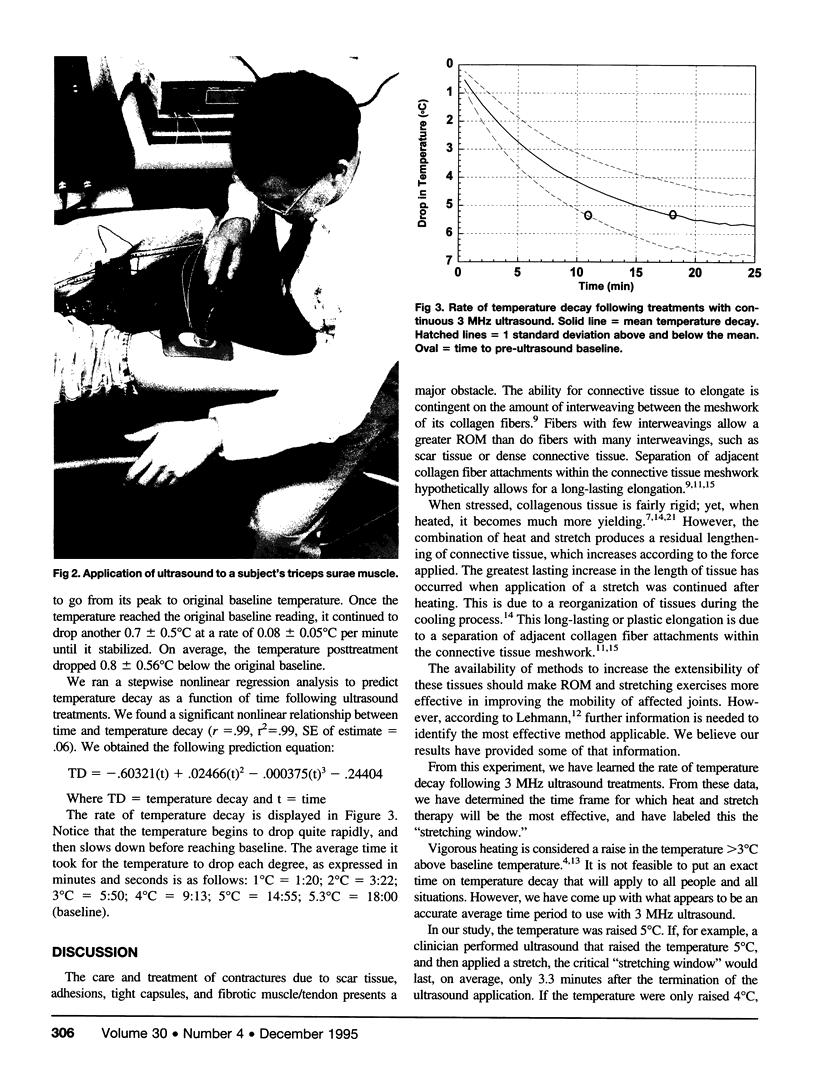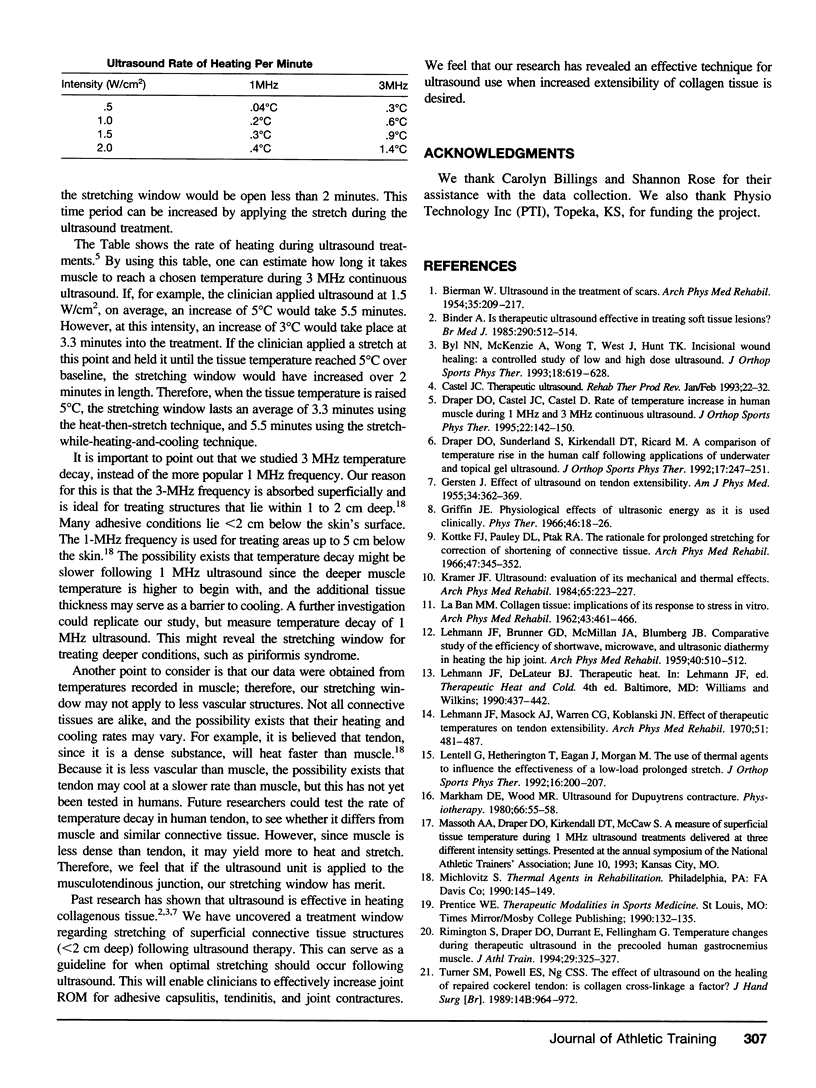Abstract
Researchers have determined that when therapeutic ultrasound vigorously heats connective tissue, it can be effective in increasing extensibility of collagen affected by scar tissue. These findings give credence to the use of continuous thermal ultrasound to heat tissue before stretching, exercise, or friction massage in an effort to decrease joint contractures and increase range of motion. Before our investigation, it was not known how long following an ultrasound treatment the tissue will remain at a vigorous heating level (>3°C). We conducted this study to determine the rate of temperature decay following 3 MHz ultrasound, in order to determine the time period of optimal stretching. Twenty subjects had a 23-gauge hypodermic needle microprobe inserted 1.2 cm deep into the medial aspect of their anesthetized triceps surae muscle. Subjects then received a 3 MHz ultrasound treatment at 1.5 W/cm2 until the tissue temperature was increased at least 5°C. The mean baseline temperature before each treatment was 33.8 ± 1.3°C, and it peaked at 39.1 ± 1.2°C from the ultrasound. Immediately following the treatment, we recorded the rate at which the temperature dropped at 30-second intervals. We ran a stepwise nonlinear regression analysis to predict temperature decay as a function of time following ultrasound treatment. We found a significant nonlinear relationship between time and temperature decay. The average time it took for the temperature to drop each degree as expressed in minutes and seconds was: 1°C = 1:20; 2°C = 3:22; 3°C = 5:50; 4°C = 9:13; 5°C = 14:55; 5.3°C = 18:00 (baseline). We conclude that under similar circumstances where the tissue temperature is raised 5°C, stretching will be effective, on average, for 3.3 minutes following an ultrasound treatment. To increase this stretching window, we suggest that stretching be applied during and immediately after ultrasound application.
Full text
PDF



Images in this article
Selected References
These references are in PubMed. This may not be the complete list of references from this article.
- BIERMAN W. Ultrasound in the treatment of scars. Arch Phys Med Rehabil. 1954 Apr;35(4):209–214. [PubMed] [Google Scholar]
- Binder A., Hodge G., Greenwood A. M., Hazleman B. L., Page Thomas D. P. Is therapeutic ultrasound effective in treating soft tissue lesions? Br Med J (Clin Res Ed) 1985 Feb 16;290(6467):512–514. doi: 10.1136/bmj.290.6467.512. [DOI] [PMC free article] [PubMed] [Google Scholar]
- Byl N. N., McKenzie A., Wong T., West J., Hunt T. K. Incisional wound healing: a controlled study of low and high dose ultrasound. J Orthop Sports Phys Ther. 1993 Nov;18(5):619–628. doi: 10.2519/jospt.1993.18.5.619. [DOI] [PubMed] [Google Scholar]
- Draper D. O., Castel J. C., Castel D. Rate of temperature increase in human muscle during 1 MHz and 3 MHz continuous ultrasound. J Orthop Sports Phys Ther. 1995 Oct;22(4):142–150. doi: 10.2519/jospt.1995.22.4.142. [DOI] [PubMed] [Google Scholar]
- Draper D. O., Sunderland S., Kirkendall D. T., Ricard M. A comparison of temperature rise in human calf muscles following applications of underwater and topical gel ultrasound. J Orthop Sports Phys Ther. 1993 May;17(5):247–251. doi: 10.2519/jospt.1993.17.5.247. [DOI] [PubMed] [Google Scholar]
- GERSTEN J. W. Effect of ultrasound on tendon extensibility. Am J Phys Med. 1955 Apr;34(2):362–369. [PubMed] [Google Scholar]
- Griffin J. E. Physiological effects of ultrasonic energy as it is used clinically. Phys Ther. 1966 Jan;46(1):18–26. doi: 10.1093/ptj/46.1.18. [DOI] [PubMed] [Google Scholar]
- Kottke F. J., Pauley D. L., Ptak R. A. The rationale for prolonged stretching for correction of shortening of connective tissue. Arch Phys Med Rehabil. 1966 Jun;47(6):345–352. [PubMed] [Google Scholar]
- Kramer J. F. Ultrasound: evaluation of its mechanical and thermal effects. Arch Phys Med Rehabil. 1984 May;65(5):223–227. [PubMed] [Google Scholar]
- LABAN M. M. Collagen tissue: implications of its response to stress in vitro. Arch Phys Med Rehabil. 1962 Sep;43:461–466. [PubMed] [Google Scholar]
- LEHMANN J. F., MCMILLAN J. A., BRUNNER G. D., BLUMBERG J. B. Comparative study of the efficiency of short-wave, microwave and ultrasonic diathermy in heating the hip joint. Arch Phys Med Rehabil. 1959 Dec;40:510–512. [PubMed] [Google Scholar]
- Lehmann J. F., Masock A. J., Warren C. G., Koblanski J. N. Effect of therapeutic temperatures on tendon extensibility. Arch Phys Med Rehabil. 1970 Aug;51(8):481–487. [PubMed] [Google Scholar]
- Markham D. E., Wood M. R. Ultrasound for Dupuytren's contracture. Physiotherapy. 1980 Feb;66(2):55–58. [PubMed] [Google Scholar]
- Rimington S. J., Draper D. O., Durrant E., Fellingham G. Temperature changes during therapeutic ultrasound in the precooled human gastrocnemius muscle. J Athl Train. 1994 Dec;29(4):325–327. [PMC free article] [PubMed] [Google Scholar]




